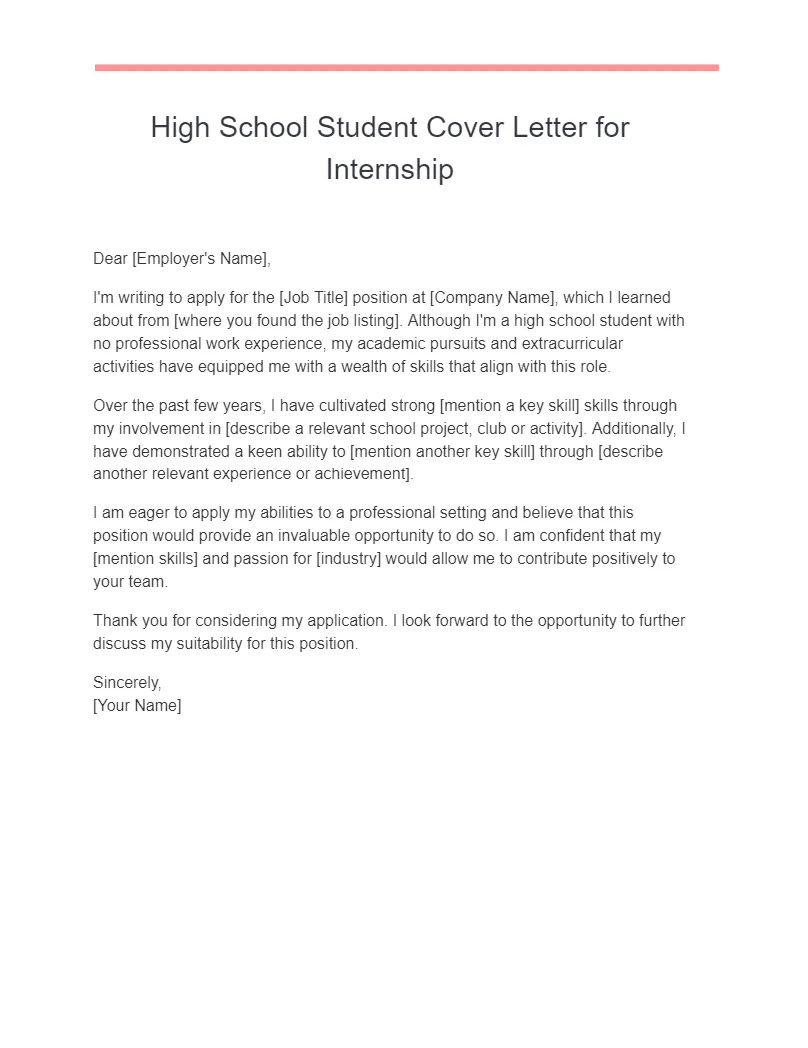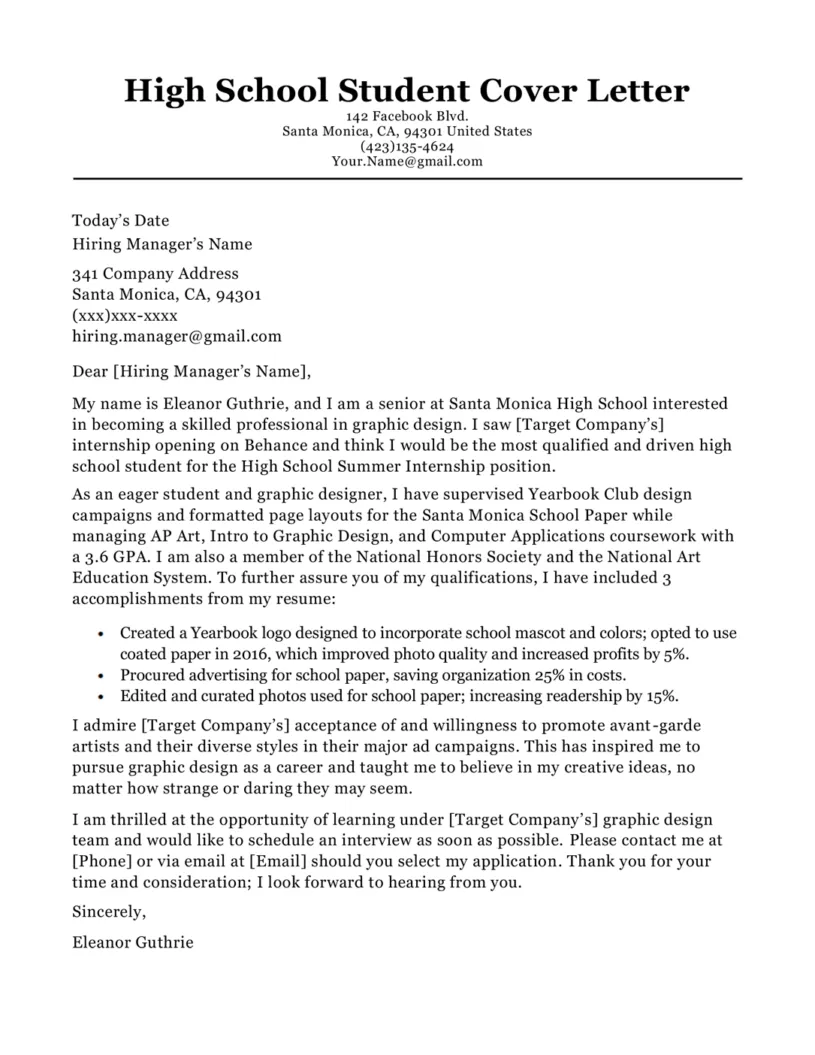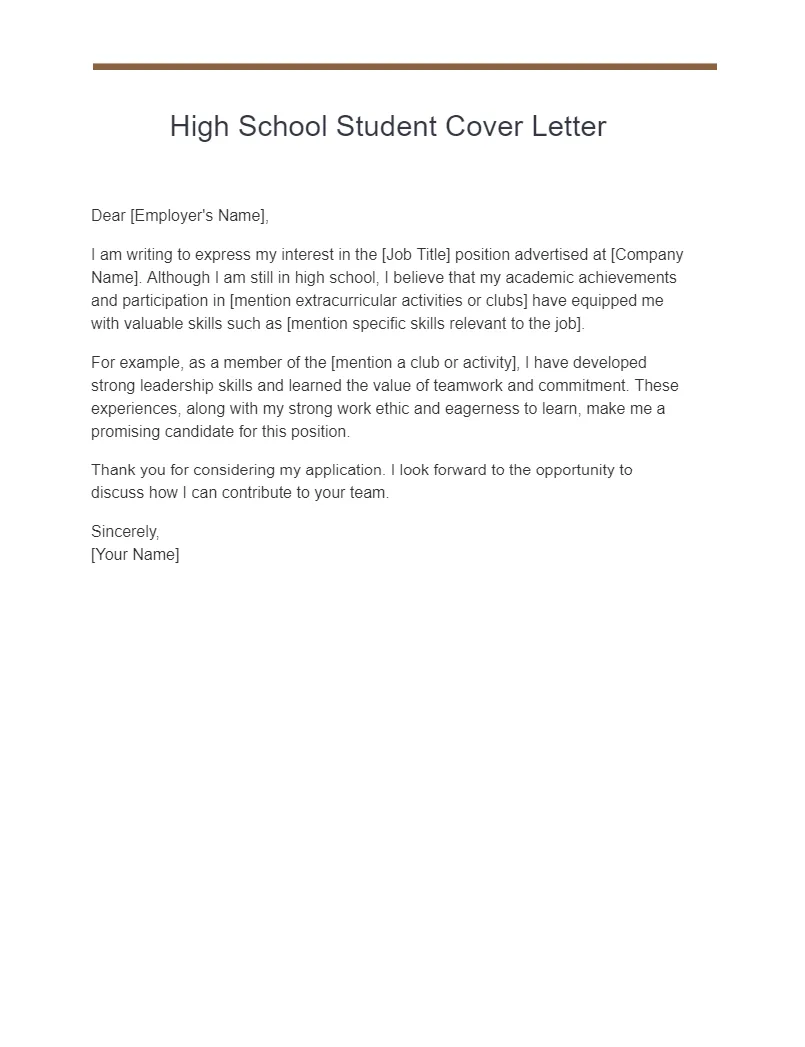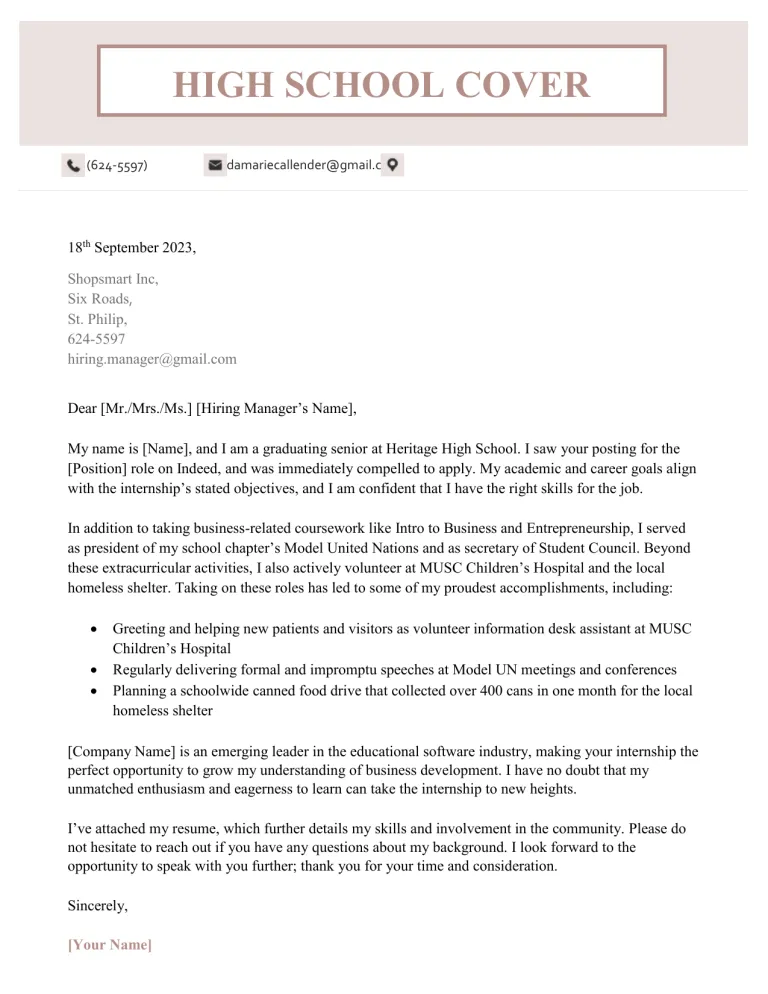What is a Cover Letter and Why Does it Matter?
A cover letter is a crucial document that accompanies your resume when you apply for a job or internship. Think of it as your personal introduction to the hiring manager, where you have the opportunity to go beyond the bullet points of your resume and truly showcase your personality, skills, and enthusiasm. It’s your chance to make a strong first impression and set yourself apart from other applicants. For students, a well-crafted cover letter is especially important, as it can compensate for a lack of extensive work experience by highlighting relevant coursework, projects, and personal qualities.
Understanding the Purpose of a Cover Letter
The primary purpose of a cover letter is to introduce yourself, express your interest in the specific role or company, and explain why you’re a suitable candidate. It allows you to connect your skills and experiences to the job requirements, demonstrating how you can contribute to the organization’s success. Furthermore, a cover letter gives you a chance to demonstrate your communication skills, writing ability, and professionalism. It’s also an opportunity to show your genuine interest in the company and its values, proving that you’ve done your research and are not just sending out generic applications.
The Importance of a Strong Cover Letter for Students

For students and recent graduates, a cover letter can be a game-changer. Without years of professional experience, it’s crucial to highlight transferable skills and academic achievements. A strong cover letter allows you to showcase relevant coursework, projects, internships, and extracurricular activities that demonstrate your abilities and potential. It provides context to your resume, making your application more compelling. It shows initiative, attention to detail, and a willingness to go the extra mile - qualities that employers highly value in entry-level candidates. By crafting a personalized cover letter, you can prove that you are a serious applicant who is genuinely interested in the opportunity.
Key Components of an Effective Student Cover Letter
A compelling student cover letter is composed of several key elements working together. A well-structured letter includes your contact information and the date, followed by a strong introduction that immediately grabs the reader’s attention. The body of the letter should highlight your skills and experiences, demonstrate your passion for the role, and explain how your background aligns with the job description. It’s crucial to tailor the letter to the specific job and company. Finally, a strong closing includes an expression of gratitude and a clear call to action. Each of these sections plays a vital role in showcasing your qualifications and making a positive impression.
Contact Information and Date
Start your cover letter by including your full name, address, phone number, and email address at the top left of the page. This information allows the hiring manager to easily contact you. Then, include the date below your contact information. Be sure to use a professional email address. Avoid using nicknames or unprofessional email handles. This demonstrates attention to detail and professionalism from the very beginning. Accuracy here is crucial; ensure all details are up-to-date and correct.
The Introduction Crafting the Hook

The introduction is your first chance to make a strong impression. Start by clearly stating the position you’re applying for and where you found the job posting. Then, create a ‘hook’ to grab the reader’s attention. Briefly explain why you are interested in the role and the company. You can mention a specific aspect of the company’s work that excites you or a particular skill that aligns with the job requirements. Keep the introduction concise and enthusiastic, setting the tone for the rest of your letter. Highlight one key achievement or skill to immediately show your value.
Highlighting Your Skills and Experience
In the body of your cover letter, focus on showcasing your relevant skills and experience. Even if you lack extensive work experience, you can draw on coursework, projects, internships, and extracurricular activities. Identify the key skills that the job description requires and provide specific examples of how you have demonstrated those skills. Use action verbs to describe your accomplishments and responsibilities, making your descriptions dynamic and engaging. Quantify your achievements whenever possible to demonstrate the impact you’ve made. This section is where you connect your qualifications to the needs of the employer.
Showcasing Relevant Coursework and Projects
For students, academic experiences often form the core of their qualifications. Highlight relevant coursework and projects that align with the job requirements. Briefly describe the projects you’ve worked on, emphasizing the skills you utilized and the results you achieved. For example, if you’re applying for a marketing position, you can mention a project where you developed a marketing campaign or analyzed consumer behavior. Similarly, if you’re applying for an engineering role, highlight projects involving design, problem-solving, or technical skills. Provide enough detail to demonstrate your understanding and abilities without overwhelming the reader.
Demonstrating Your Passion and Enthusiasm

Employers want to hire individuals who are genuinely interested in the role and the company. Show your enthusiasm by expressing your passion for the industry, the company’s mission, or the specific tasks outlined in the job description. Explain why you’re excited about the opportunity and how it aligns with your career goals. Mention any research you’ve done about the company, their recent achievements, or their values that resonate with you. Be specific and authentic in your expressions. Authenticity can make a memorable impression, setting you apart from other candidates who may appear less engaged.
Tailoring Your Cover Letter to the Job Description
One of the most critical aspects of writing a successful cover letter is tailoring it to the specific job description. Carefully read the job posting and identify the key skills, qualifications, and requirements the employer is seeking. Then, use your cover letter to directly address these requirements, providing specific examples of how your skills and experiences align with their needs. Don’t just reiterate your resume; instead, provide context, elaborate on your accomplishments, and explain why you are the ideal candidate. Personalize your letter to demonstrate that you understand the role and have taken the time to consider the job requirements.
Researching the Company and Understanding Their Needs
Before you start writing your cover letter, take the time to research the company. Visit their website, read their ‘About Us’ page, and explore their social media presence. Understanding the company’s mission, values, and recent achievements will help you tailor your letter and demonstrate your genuine interest. Look for any current projects, initiatives, or challenges the company is facing, and consider how your skills and experience can contribute to their success. This research will help you personalize your letter and show the hiring manager that you’ve done your homework and understand the company’s needs. Demonstrating that you have a grasp of their business is an excellent way to stand out.
Using Keywords to Match the Job Requirements

Many companies use Applicant Tracking Systems (ATS) to screen resumes and cover letters. To ensure your application gets noticed, incorporate keywords from the job description into your cover letter. Identify the key skills, qualifications, and phrases used in the job posting and integrate them naturally into your writing. Avoid keyword stuffing; instead, use these terms in context to describe your skills, experiences, and accomplishments. This will help your cover letter pass through the ATS and make it to the hiring manager’s desk. This technique helps to ensure your application is visible to the hiring team.
Formatting and Structure
The formatting and structure of your cover letter play a significant role in making it professional and easy to read. Maintain a clean and organized layout. Use clear headings and subheadings to break up the text and guide the reader. Keep paragraphs concise, with each paragraph addressing a specific point. Ensure your letter has a logical flow, starting with your introduction and moving through your skills, experiences, and concluding with a call to action. A well-formatted cover letter demonstrates attention to detail and respect for the reader’s time.
Choosing the Right Font and Font Size
Selecting the right font and font size is crucial for readability. Use a professional, easy-to-read font like Times New Roman, Arial, or Calibri. Ensure the font size is between 10 and 12 points to ensure readability without appearing too large or small. Maintaining consistency throughout your letter is also important. Don’t mix different fonts or font sizes. Stick to a single font for the entire document to maintain a consistent and professional look. These small details enhance readability, which is important to the hiring manager.
Using a Professional and Readable Layout

Adopt a professional and readable layout to make your cover letter visually appealing. Use standard margins (1 inch on all sides) to provide sufficient white space. Left-align your text and avoid excessive use of bolding or italics. Ensure your letter is properly spaced and that paragraphs are separated. Avoid using distracting colors or graphics. Keep the design simple and clean. The goal is to create a document that is easy on the eyes and allows the reader to focus on your content. A clean layout signals your professionalism and attention to detail.
Proofreading and Editing Your Cover Letter
Proofreading and editing are essential steps in the cover letter writing process. Before submitting your letter, carefully proofread it for any grammatical errors, spelling mistakes, and typos. Even a minor error can undermine your credibility. Read your letter aloud to catch any awkward phrasing or sentence structures. It’s also helpful to have a friend, career counselor, or family member review your letter for feedback. They can provide a fresh perspective and help you identify any areas for improvement. Proofreading is a critical step, so don’t skip it.
Checking for Grammar and Spelling Errors
Pay close attention to grammar and spelling errors. Use a spell checker and grammar checker, but don’t rely on them entirely. Proofread your letter carefully to catch any errors the software might miss. Ensure that your sentences are well-structured, and the language is clear and concise. Avoid using slang, jargon, or informal language. The goal is to present yourself as a polished and professional candidate. Errors undermine your credibility, which can disqualify your application. Taking the time to eliminate errors can significantly enhance your chances of success.
Getting Feedback and Making Revisions
Seeking feedback is a crucial step in refining your cover letter. Ask trusted friends, family members, career counselors, or professors to review your letter and provide their honest opinions. Ask for feedback on the clarity, structure, and overall effectiveness of your letter. Pay attention to their suggestions and use them to revise your letter. Don’t be afraid to make changes based on feedback. The more feedback you receive, the better your letter will become. This collaborative approach can lead to significant improvements in your cover letter and increase your chances of getting hired.
The Closing and Call to Action
The closing is your last opportunity to leave a lasting impression. In the closing paragraph, express your gratitude for the reader’s time and consideration. Reiterate your interest in the role and the company. Include a clear call to action, such as stating that you look forward to hearing from them soon or that you are available for an interview at their earliest convenience. Provide your contact information again to ensure that they can easily get in touch with you. A well-crafted closing reinforces your professionalism and enthusiasm.
Expressing Gratitude and Offering Availability
As you close your cover letter, express your sincere gratitude for the hiring manager’s time and consideration. Thank them for reviewing your application and for considering you for the position. Reiterate your enthusiasm for the opportunity. Also, offer your availability for an interview. You can specify that you are available at their earliest convenience or mention specific dates and times when you are available. Ending with a positive, proactive note can help you stand out and increase your chances of moving forward in the hiring process.
Following Up After Submitting Your Application
After submitting your application, follow up with the hiring manager. Send a brief email expressing your continued interest and confirming that they received your application. This shows your initiative and professionalism. Do this one or two weeks after submitting the application. If the company has a specific follow-up policy, adhere to it. A well-timed follow-up can reinforce your interest and make you a more memorable candidate. While you should not be pushy, a brief, polite follow-up demonstrates your enthusiasm and commitment.
